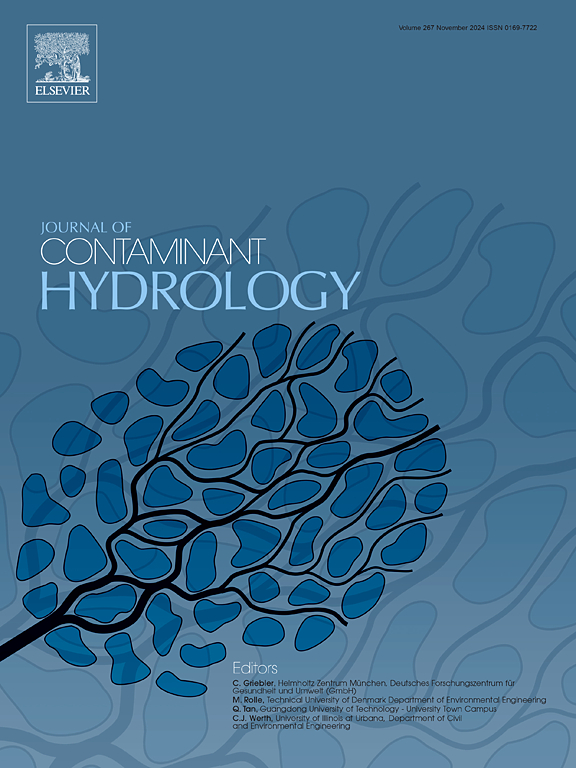红茶废渣/铁渣活性过滤介质-电动法处理污染场地混合重金属
IF 3.5
3区 环境科学与生态学
Q2 ENVIRONMENTAL SCIENCES
引用次数: 0
摘要
电动力学(EK)修复是一种利用电场从土壤中提取重金属的前沿技术。本研究探讨了将EK修复与粉状铁渣/红茶废料(PIS/BTW)和粒状铁渣/红茶废料(GIS/BTW)组成的活性过滤介质(RFM)相结合,提高高岭石和天然土壤中单一和混合重金属的去除效率。结果表明,PIS/BTW在重金属提取方面明显优于GIS/BTW,铜的去除率为98.75%,而GIS/BTW的去除率为90.06%。在3周的时间里,回收的rfm对铜的去除率达到了91.28%,对GIS/BTW的去除率为84.90%。比能量消耗(SEC)随处理时间的延长而增加,高岭土的比能量消耗为0.055 ~ 0.254 kWh kg - 1,天然土的比能量消耗为0.344 kWh kg - 1。对于重金属混合物,在高岭土中,4周后铜、镍和锌的去除率分别为97.15%、98.30%和96.68%,而在自然土中,5周后铜、镍和锌的去除率分别为16.39%、89.22%和84.38%。rfm的碱性pH有利于金属离子的吸附和沉淀,有利于金属离子的固定化。本研究证明了利用可回收的生态友好型rfm优化EK修复的有效性,为解决土壤重金属污染提供了可持续、高效的解决方案。本文章由计算机程序翻译,如有差异,请以英文原文为准。
Black tea waste/iron slag reactive filter media-electrokinetic for mixed heavy metals treatment from contaminated site
Electrokinetic (EK) remediation is a cutting-edge technique used for extracting heavy metals from soils by applying an electric field. This study explores the integration of EK remediation with reactive filtration media (RFM) composed of recycled waste materials of powder iron slag/black tea waste (PIS/BTW) and granular iron slag/black tea waste (GIS/BTW) to improve the removal efficiency of single and mixed heavy metals from kaolinite and natural soils. Results demonstrated that PIS/BTW significantly outperformed GIS/BTW in heavy metal extraction, achieving 98.75 % copper removal compared to 90.06 % with GIS/BTW. Recycled RFMs achieved excellent copper removal, reaching 91.28 % for PIS/BTW and 84.90 % for GIS/BTW over 3 weeks. Specific energy consumption (SEC) increased with treatment durations, ranging from 0.055 to 0.254 kWh kg−1 in kaolin soil, while 0.344 kWh kg−1 increased in natural soil. For a heavy metals mixture in kaolinite soil, the removal of copper, nickel, and zinc achieved 97.15 %, 98.30 %, and 96.68 %, respectively, after 4 weeks, while in natural soil, the removal rates for copper, nickel, and zinc were 16.39 %, 89.22 %, and 84.38 % after 5 weeks. The alkaline pH of the RFMs facilitated the adsorption and precipitation of metal ions, contributing to their immobilization. The research study demonstrated the effectiveness of using recyclable and eco-friendly RFMs to optimize EK remediation, providing a sustainable and efficient solution for addressing heavy metal contamination in soils.
求助全文
通过发布文献求助,成功后即可免费获取论文全文。
去求助
来源期刊

Journal of contaminant hydrology
环境科学-地球科学综合
CiteScore
6.80
自引率
2.80%
发文量
129
审稿时长
68 days
期刊介绍:
The Journal of Contaminant Hydrology is an international journal publishing scientific articles pertaining to the contamination of subsurface water resources. Emphasis is placed on investigations of the physical, chemical, and biological processes influencing the behavior and fate of organic and inorganic contaminants in the unsaturated (vadose) and saturated (groundwater) zones, as well as at groundwater-surface water interfaces. The ecological impacts of contaminants transported both from and to aquifers are of interest. Articles on contamination of surface water only, without a link to groundwater, are out of the scope. Broad latitude is allowed in identifying contaminants of interest, and include legacy and emerging pollutants, nutrients, nanoparticles, pathogenic microorganisms (e.g., bacteria, viruses, protozoa), microplastics, and various constituents associated with energy production (e.g., methane, carbon dioxide, hydrogen sulfide).
The journal''s scope embraces a wide range of topics including: experimental investigations of contaminant sorption, diffusion, transformation, volatilization and transport in the surface and subsurface; characterization of soil and aquifer properties only as they influence contaminant behavior; development and testing of mathematical models of contaminant behaviour; innovative techniques for restoration of contaminated sites; development of new tools or techniques for monitoring the extent of soil and groundwater contamination; transformation of contaminants in the hyporheic zone; effects of contaminants traversing the hyporheic zone on surface water and groundwater ecosystems; subsurface carbon sequestration and/or turnover; and migration of fluids associated with energy production into groundwater.
 求助内容:
求助内容: 应助结果提醒方式:
应助结果提醒方式:


